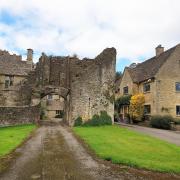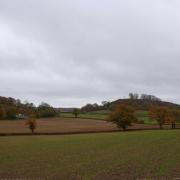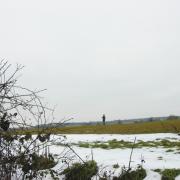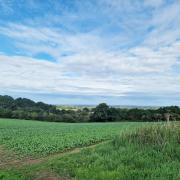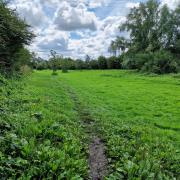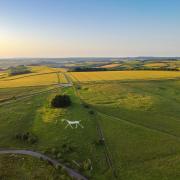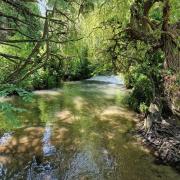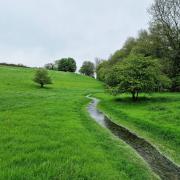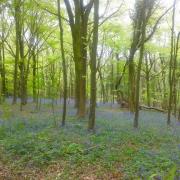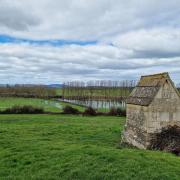On the trail of Wayland the Smith on the Ridgeway to one of Britain’s oldest monuments, the Neolithic long barrow called Wayland’s Smithy
This walk takes us to one of Britain’s oldest monuments, the Neolithic long barrow called Wayland’s Smithy on the Ridgeway in Oxfordshire. The ancient Nordic myth of Wayland is a dark tale of betrayal, enslavement, murder, and rape, but in England he has evolved into an irascible old fairy smith who haunts the long barrow. If your horse has lost a shoe, you simply bring the horse and a silver sixpence, no more, no less, and in the morning your horse will be shod.
The walk starts in the village square in Ashbury. Take the bridle path beside the Rose and Crown pub to the church. Here you’ll find a fascinating chapel dedicated to St Hubert, the patron saint of hunting, who was converted to the Christianity when, mourning his wife’s death, he saw a hart with a crucifix between his antlers.

Make your way through the churchyard to rejoin the bridle path and follow this up to the ridge. The Ridgeway is an ancient trackway, as familiar to the Neolithic herdsmen who built Wayland’s Smithy as it is to us today, which follows the high ground over the downs from Avebury to Streatley. A short way east along the Ridgeway you’ll see a path into a gallery of beech woodland on the right. Duck inside to enjoy the green shade until you reach the cross-track back to the Ridgeway.
Wayland’s Smithy is a short way further on inside a copse on the left. It’s an impressive structure, 5500 years old, and similar to the older long barrow at West Kennet. Here the Neolithic people of the area buried a select few of their dead. We know little of what the Celts and Romans thought of the site, but when the Saxons came they knew exactly what it was. It was the home of a character in their stories – Weland, or Wayland, the Smith.

Wayland appears in the Norse eddas and sagas, but the earliest mention of his story in English is in the tenth-century poem ‘Deor’. He was the son of a giant, Wade, (who may or may not be a Yorkshireman…) and was trained in smithcraft by the dwarves. He had a swan-wife, having stolen her swan-coat, only to lose her once she found the coat. That was just the beginning of his sorrows. Captured, lamed, and imprisoned on an island by King Nithhad, he took his revenge by murdering the King’s young sons and raping the King’s daughter, Beadohild, and leaving her with child. He fashioned cups from the boys’ skulls, and jewels from their teeth. Then he made wings from the feathers of the birds that alighted on his lonely prison and took flight back to his smithy, where he lived on, making and mending.
When you’ve soaked up the atmosphere at Wayland’s Smithy, return to the Ridgeway and continue towards Uffington Castle. When the Anglo-Saxons came to Britain, they brought their stories with them. The name ‘Welandes Smithan’ first appears in a tenth-century boundary charter from the place we’re heading to next, Compton Beauchamp. Perhaps the Anglo-Saxons tried to make sense of the land they’d arrived in by translocating the stories of their gods and ancestors. Wayland was well known enough that King Alfred asked in his writings, ‘Where lie the bones of Weland?’ Uffington is famous for its Bronze Age chalk figure, but the Saxons ascribed the White Horse to their founding father, Hengist, who made it in memory of his brother Horsa.

If you wanted, you could extend this walk to take in Uffington Castle. To follow our route, however, continue along the Ridgeway, past the end of a minor road, and look out for the sign (on your right) indicating the right of way through the field to your left. The route isn’t very obvious; just head towards the isolated tree visible on the horizon. This turns out to be the start of a gallery of trees shading the path onwards to the road. On your right is the earth rampart of a steep drop into Hardwell Camp. This was an Iron Age fort, but in Saxon times a mound there was named ‘Wittich’s Barrow’, another reminder of Wayland’s story, since Wittich was the child whom Beadohild bore him. Her own grave lay a mile or so further east.
Cross the B4507, and proceed to the left, careful of the traffic, to the crossroads. A right turn takes you to Compton Beauchamp. Just past Compton House is the entry to the exquisite church and its peaceful churchyard. Retrace your steps to the road and follow it out past Compton Marsh Farm. If you look back you can see Uffington White Horse. When the road bends to the right, continue straight on up the track to Odstone Marsh Farm. The stile just past the farm on the left is hidden in the hedge. The path from here crosses a second stile and then heads diagonally across a field. We’re now on the trail of a rather different Wayland tale.
After crossing a footbridge, turn left, through a gap in the hedge, and follow the path, crossing the stream twice more. After a nook of woodland, you’ll find yourself in the corner of a field. Ahead on the Ridgeway you can just make out the copse containing Wayland’s Smithy jutting from beyond a nearer tract of woodland. If you can see up there, then Wayland can see down to you! Once, long ago, Wayland ran out of nails and sent his assistant, Flibbertigibbit, down to Ashbury to get some. But the boy, true to his name, fell in with the local lads and set off with them across the marsh, laughing and kicking a ball about, forgetting all about his errand.

Up on the ridge, Wayland waited, getting crosser and crosser, until, as he paced about, he spotted the boy larking with the other lads. Furious, he picked up a big stone and hurled it down at the boy. It soared the full mile and a half and caught him on the heel. While the other boys scattered, Flibbertigibbit sat snivelling and nursing his bashed foot. The stone stuck fast in the ground, two feet high and three feet long! There it stayed till the 1960s, when it was removed who knows whither. But the name remains – Snivelling Corner.

We must follow poor limping Flibbertigibbit back to Ashbury. Follow the field boundary, cross another bridge on the right, then walk diagonally across two fields into Kingstone Winslow. Bear left past the telephone box library and then turn right along the bridle path past the old mill and millpond, emerging beside a modern chapel. Cross the road and head down Chapel Road, keeping left till you’re back in the village square, where perhaps Flibbertigibbit collected his nails and went, snivelling still, back to Wayland’s Smithy. But the question we’d ask for today’s Ridgeway riders is this: if your bike gets a puncture, will Wayland fix it for sixpence?
ESSENTIALS
Distance: 7 miles.
Duration: 5 hours.
Level: Some moderate ascents and descents. Some of the walk is on tarmac.
Parking: Road parking in Ashbury.
Toilets and refreshments: Rose and Crown and Ashbury Tea Room and Shop, Ashbury. Public toilets on Sheep Street.
Transport links: West Berkshire Council Transport Services buses 47 and 47B run through Ashbury.
Map: OS Explorer 170 Vale of the White Horse.
Further reading: Oxfordshire Folk Tales, by Kevan Manwaring; Villages of the White Horse, by Alfred Williams.
LINKS
Route: gb.mapometer.com/walking/route_5263599
Wayland’s Smithy: www.english-heritage.org.uk/visit/places/waylands-smithy/history

Kirsty Hartsiotis and Anthony Nanson are Stroud-based storytellers and writers. Their books include Gloucestershire Folk Tales, Wiltshire Folk Tales, Gloucestershire Ghost Tales, Gloucestershire Folk Tales for Children, and Anthony’s brand-new Storytelling and Ecology. Kirsty is also the curator of decorative and fine art at The Wilson Art Gallery and Museum, Cheltenham. Anthony runs the small press Awen Publications.






